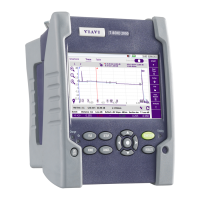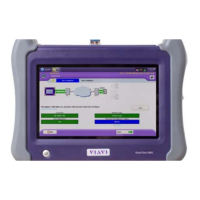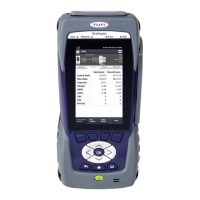Do you have a question about the Viavi T-BERD MTS 5800 and is the answer not in the manual?
Explains manual purpose, scope, user assumptions, and defines key terms.
Lists related manuals, describes document conventions, safety/compliance info, and technical assistance contacts.
Describes T-BERD/MTS/SC instruments and their supported electrical/optical interfaces and capabilities.
Explains that instruments are factory-configured, and how to discuss specific configurations or options.
Lists typical items shipped with the instrument, including base units, modules, PIMs, and documentation.
Describes Viavi's typical shipping method using anti-static packing material.
Instructs users to examine components for damage after unpacking and to contact Viavi Customer Care if damage is found.
Lists available accessories for the instruments, such as transceivers and cables.
Lists available optional expansion modules for product families and test instruments.
Describes the T-BERD/MTS 5800 and Smart Class 4800/4800P as rugged, portable, battery-operated test solutions.
Explains CSAM usage with 6000A/8000 base units and DMC chassis, and its factory configuration.
Explains MSAM usage with 6000A/8000 base units and DMC chassis, and its factory configuration.
Describes the DMC chassis for the T-BERD/MTS 8000 base unit, providing slots for MSAM/CSAM modules.
Recommends purchasing adapters and transceivers from Viavi for proper instrument operation.
Provides instructions to review unpacking and inspection before assembling instrument components.
Details key principles and base unit requirements for connecting a DMC to a T-BERD/MTS 8000 base unit.
Guides on inserting MSAM or CSAM modules into the 6000A base unit or DMC chassis.
Explains how to insert, remove, and swap Physical Interface Modules (PIMs) in the MSAM.
Explains the process of disconnecting the DMC from the base unit, reviewing key principles.
Covers powering the instrument, launching modules, and managing BERT icons and jitter functions.
Describes the instrument's UI elements like menu bar, soft keys, setup/results screens, and message box.
Guides on international settings, date/time, passwords, display, UI customization, options, upgrades, and synchronization.
Covers specifying printers, connecting to circuits, and configuring expert optical settings.
Covers test preparation, synchronization, GPS/CDMA connections, and selecting test applications.
Details test configuration, entering data, saving setups, and connecting the instrument to the circuit.
Explains starting tests, using action buttons, controlling lasers, and viewing/manipulating test results.
Covers running multiple tests, scheduling timed tests, creating/printing reports, and restoring defaults.
Explains VT-100 emulation, establishing serial connections, and using the HTML Viewer.
Details remote connection methods: wired Ethernet, WiFi, or Smartphone Data Tethering.
Details launching the utility on instrument/workstation and displaying the instrument's remote UI.
Describes single file transfers between workstation and instrument via the file manager utility.
Covers reviewing session information and modifying connection settings like SSI tunnel port and Internet proxy.
Explains how to enable Bluetooth, allow pairing, and find devices for file transfers or audio use.
Details the process of transferring files between the instrument and paired devices via Bluetooth.
Guides on connecting to paired Bluetooth audio devices like headsets or loudspeakers.
Explains how to disconnect a paired device and remove its pairing from the instrument.
Describes how to deactivate the Bluetooth application on the instrument.
Details using the Optical Power Meter accessory to measure optical power at specific wavelengths.
Covers physical, power, electrical Ethernet, and timing specs for these instruments.
Details specs for MSAM chassis, PIMs, and various interface types (e.g., X.21, RS-232, EIA-530).
Provides specs for electrical and optical jitter and wander measurements for MSAM.
Outlines physical, power supply, battery, and optical specs for the CSAM.
Directs users to manufacturer websites for detailed transceiver and adapter specs.
Lists environmental characteristics for T-BERD/MTS 5800/SC 4800 and MSAM.
Provides guidelines for maintaining rechargeable lithium-ion batteries for longevity.
Offers guidance for solving common instrument problems like power, printing, USB, and software issues.
Addresses issues in assembly, setup, operating the instrument, and performing tests.
Covers instrument maintenance, calibration frequency, and component insertion rates.
Discusses potential issues with battery gauge reading and restoring battery communication.
Provides criteria for storing the Dual Module Carrier, CSAM, MSAM, T-BERD/MTS 5800, and SC 4800.
Outlines guidelines to follow if the instrument needs to be shipped.
Instructs users to contact Viavi Customer Care for return authorization and proper shipping procedures.
| Platform Type | Handheld |
|---|---|
| Supported Technologies | Ethernet, Fibre Channel, OTN, SONET/SDH, PDH |
| Ethernet Testing | Yes |
| Fibre Channel Testing | Yes |
| OTN Testing | Yes |
| SONET/SDH Testing | Yes |
| PDH Testing | Yes |
| Synchronization Testing | Yes |
| Battery Life | Up to 8 hours |
| Operating Temperature | -10°C to 50°C |
| Optical Testing | Yes |
| OTDR Testing | Yes |
| Power Meter | Yes |
| Light Source | Yes |
| Fiber Inspection | Yes |
| Humidity | 5% to 95% non-condensing |
| IP Rating | IP54 |
| Storage Temperature | -20°C to 60°C |
| Display | 7-inch touchscreen |











